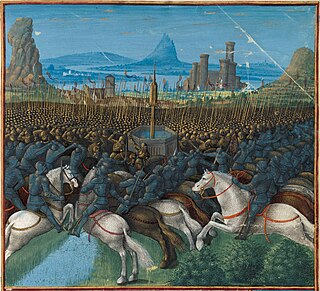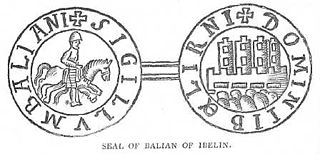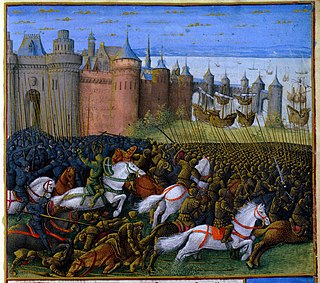
The Kingdom of Jerusalem, also known as the Latin Kingdom, was a Crusader state that was established in the Levant immediately after the First Crusade. It lasted for almost two hundred years, from the accession of Godfrey of Bouillon in 1099 until the fall of Acre in 1291. Its history is divided into two periods with a brief interruption in its existence, beginning with its collapse after the siege of Jerusalem in 1187 and its restoration after the Third Crusade in 1192.
The 1100s was a decade of the Julian Calendar which began on January 1, 1100, and ended on December 31, 1109.
Year 1108 (MCVIII) was a leap year starting on Wednesday of the Julian calendar.

The First Crusade (1096–1099) was the first of a series of religious wars, or Crusades, initiated, supported and at times directed by the Latin Church in the middle ages. The objective was the recovery of the Holy Land from Islamic rule. While Jerusalem had been under Muslim rule for hundreds of years, by the 11th century the Seljuk takeover of the region threatened local Christian populations, pilgrimages from the West, and the Byzantine Empire itself. The earliest initiative for the First Crusade began in 1095 when Byzantine emperor Alexios I Komnenos requested military support from the Council of Piacenza in the empire's conflict with the Seljuk-led Turks. This was followed later in the year by the Council of Clermont, during which Pope Urban II supported the Byzantine request for military assistance and also urged faithful Christians to undertake an armed pilgrimage to Jerusalem.

Lord Edward's Crusade, sometimes called the Ninth Crusade, was a military expedition to the Holy Land under the command of Edward, Duke of Gascony in 1271–1272. It was an extension of the Eighth Crusade and was the last of the Crusades to reach the Holy Land before the fall of Acre in 1291 brought an end to the permanent crusader presence there.

The Battle of Montgisard was fought between the Kingdom of Jerusalem and the Ayyubid Dynasty on 25 November 1177 at Montgisard, in the Levant between Ramla and Yibna. The 16-year-old Baldwin IV of Jerusalem, severely afflicted by leprosy, led outnumbered Christian forces against Saladin's troops in what became one of the most notable engagements of the Crusades. The Muslim Army was quickly routed and pursued for twelve miles. Saladin fled back to Cairo, reaching the city on 8 December, with only a tenth of his army. Muslim historians considered Saladin's defeat to be so severe that it was only redeemed by his victory ten years later at the battles of Cresson and Hattin and the Siege of Jerusalem in 1187. Saladin did defeat Baldwin IV in the Battle of Marj Ayyun and the Siege of Jacob’s Ford in 1179, only to be defeated by Baldwin again at the Battle of Belvoir Castle in 1182 and the Siege of Kerak in 1183.
Sigurd Magnusson, also known as Sigurd the Crusader, was King of Norway from 1103 to 1130. His rule, together with his half-brother Øystein, has been regarded by historians as a golden age for the medieval Kingdom of Norway. He is otherwise famous for leading the Norwegian Crusade (1107–1110), earning him the eponym "the Crusader", and was the first European king to participate in a crusade personally.

Kungälv is a city and the seat of Kungälv Municipality in Västra Götaland County, Sweden. It is also a part of Greater Gothenburg Metropolitan Area. It had 22,768 inhabitants in 2010. In 2021, the main Kungälv - Ytterby - Kareby conurbation had a combined population approaching 30,000.

The Battle of Cresson was a small battle between Frankish and Ayyubid forces on 1 May 1187 at the "Spring of the Cresson." While the exact location of the spring is unknown, it is located in the environs of Nazareth. The conflict was a prelude to decisive defeat of the Kingdom of Jerusalem at the Battle of Hattin two months later.

Eysteinn Magnusson was king of Norway from 1103 to 1123 together with his brothers Sigurd the Crusader and Olaf Magnusson, although since Olaf died before adulthood, only Eystein and Sigurd were effective rulers of the country.

Balian of Ibelin, also known as Barisan the Younger, was a crusader noble of the Kingdom of Jerusalem in the 12th century. He was lord of Ibelin from 1170 to 1193. As the leader of the defense of the city during the siege of Jerusalem in 1187, he surrendered Jerusalem to Saladin on 2 October 1187.
Eustace I Granier, also known as Eustace Grenier or Eustace Garnier, called in Latin Eustachius Granarius in the charters, was a Flemish crusader who took part in the First Crusade. He became lord of Caesarea in 1101 and lord of Sidon in 1110. On 18 April 1123, he was elected constable and bailiff of Jerusalem during the captivity of Baldwin II of Jerusalem. Shortly before his death, he defeated a Fatimid army at the Battle of Yibneh near Ibelin.
Eustace Grenier is quoted in a text in verse written during his life in honour of the knights of the diocese of Thérouanne who accompanied Baldwin of Boulogne to the Holy Land.
Contemporary authors and historians identify Eustace Grenier as a nobleman from the diocese of Thérouanne in the County of Saint-Pol. Alan V. Murray, historian of the Crusades, writes: "However, his origins can be established with a high degree of certainty. The Versus de viris illustribus diocesis Tarvanensis qui in sacra fuere expeditione identifies him as a Fleming from the diocese of Therouanne".

The Crusades were a series of religious wars initiated, supported, and sometimes directed by the Christian Latin Church in the medieval period. The best known of these military expeditions are those to the Holy Land in the period between 1095 and 1291 that had the objective of reconquering Jerusalem and its surrounding area from Muslim rule after the region had been conquered by the Rashidun Caliphate centuries earlier. Beginning with the First Crusade, which resulted in the conquest of Jerusalem in 1099, dozens of military campaigns were organised, providing a focal point of European history for centuries. Crusading declined rapidly after the 15th century.

The Battle of Marj Ayyun was a military confrontation fought at Marj Ayyoun near the Litani River in June 1179 between the Kingdom of Jerusalem under Baldwin IV and the Ayyubid armies under the leadership of Saladin. It ended in a decisive victory for the Muslims and is considered the first in the long series of Islamic victories under Saladin against the Christians. However, the Christian King, Baldwin IV of Jerusalem, who was crippled by leprosy, was saved by his bodyguard and narrowly escaped capture.

The siege of Sidon was an event in the aftermath of the First Crusade. The coastal city of Sidon was captured by the forces of Baldwin I of Jerusalem and Sigurd I of Norway, with assistance from the Ordelafo Faliero, Doge of Venice.
The Hardrada dynasty was a powerful royal dynasty which ruled, at various times in history, the Kingdom of Norway, the Kingdom of Mann and the Isles, and the Earldom of Orkney.

The siege of Tyre took place from 12 November 1187 to 1 January 1188. An army commanded by Saladin made an amphibious assault on the city, defended by Conrad of Montferrat. After two months of continuous struggle, Saladin dismissed his army and retreated to Acre.
Events in the year 1130 in Norway.

The Barons' Crusade (1239–1241), also called the Crusade of 1239, was a crusade to the Holy Land that, in territorial terms, was the most successful crusade since the First Crusade. Called by Pope Gregory IX, the Barons' Crusade broadly embodied the highest point of papal endeavor "to make crusading a universal Christian undertaking." Gregory IX called for a crusade in France, England, and Hungary with different degrees of success. Although the crusaders did not achieve any glorious military victories, they used diplomacy to successfully play the two warring factions of the Ayyubid dynasty against one another for even more concessions than Frederick II had gained during the more well-known Sixth Crusade. For a few years, the Barons' Crusade returned the Kingdom of Jerusalem to its largest size since 1187.
The siege of Beirut was an event in the aftermath of the First Crusade. The coastal city of Beirut was captured from the Fatimids by the forces of Baldwin I of Jerusalem on 13 May 1110, with the assistance of Bertrand of Toulouse and a Genoese fleet.















